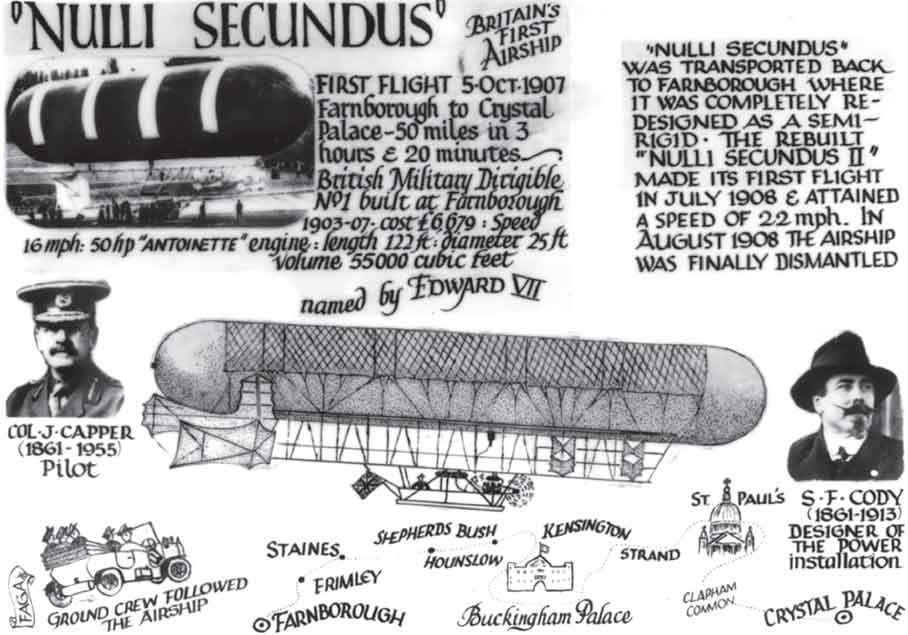‘Air Battles of the Future’
The following article appeared in the Daily Mail in October 1907 and was copied to other newspapers around the world:
AIR BATTLES OF THE FUTURE.
TERRIBLE POSSIBILITIES OF AERIAL WARFARE.
By Dr Rudolf Martial, a Councillor of the German Government.
The battle-airships possessed by Great Britain, France and Germany: Great Britain – Nulli Secundus, constructed at Aldershot; travelled on Saturday fifty miles, crossed London, was in the air 3–4 hours, and the highest speed attained in light air was at the rate of forty miles an hour. France – La Patrie; has manoeuvred over Paris, travelled through the air for 6 hours and 15 minutes, and covered forty miles. Her speed against wind was at the rate of eighteen miles an hour, Germany – The Gross and the Parseval, both constructed by German Army officers; each has manoeuvred over Berlin. The Gross is said to carry six men, searchlights, and wireless telegraphy instruments; she remained in the air 3 hours 50 minutes, and went against the wind at a speed equal to 12 miles an hour. Count Zeppelin’s large aluminium airship, which is also reported to have been bought by Germany, can carry thirty persons, and is said to be capable of travelling 528 miles. In the aerial war of the near future man will be staggered, not by the spectacle, but by the slaughter. For the spectator there will be little to see beyond a number of faint grey linear objects, like whetstones silhouetted against the sky. But each of these drab-coloured objects is an airship which can easily carry from ten to fifty torpedoes, weighing from 110lb to 165lb. The havoc wrought by a small fleet of Zeppelin airships would be frightful. It could pursue the fastest battleship and send it to the bottom. The battleship is at a terrible disadvantage: it is easily damaged from above; it has a speed of twenty-five knots, against a speed of nearly thirty knots possessed by its adversary. Pursue the comparison to questions of cost and of crew. La Patrie, costing £12,000, with a crew of three, and Count Zeppelin’s giant airship, costing £25,000, with a crew of six, are each capable of annihilating a battleship, value £2,000,000, with a crew of nearly 1000 men.
Small flexible motor-airships, of so little bulk that they can be stowed away in a couple of carts, can easily be carried on a battleship and inflated on board with compressed gas from steel bottles. Thus the battle-airship will take its place with the heavy guns and the torpedoes as part of the equipment of a battleship. To a motor-airship, the North Sea or the Mediterranean is no more than a large pond. Count Zeppelin’s aluminium airship can travel 850 kilometres without taking in any benzine. The action of radius of Lebaudy’s Patrie, or of the Parseval motor-airship, both of which have a considerably smaller gas capacity, may be ‘estimated’ at from 225 kilometres to 250 kilometres. At its narrowest point the English Channel only measures 31 kilometres across and the distance from Nordholz to England is about 400 kilometres. With airfleets constructed upon Count Zeppelin’s system it would be possible to drive away from the North Sea all squadrons of the fleet which are not protected by battle-airships. An aerial fleet which, during the day, has helped to decide the issue of a battle near Sedan, can, the same evening or during the night, annihilate a battle-fleet in the English Channel, which is only 200 kilometres distant. The air-fleet which has been beaten in battle on land will be driven to sea by the enemy’s air-fleet. It will be put out of action by being prevented from taking in a fresh supply of benzine. A fleet so pursued would probably be fired upon by the victor, at the same time, from the land and from the sea. The most important principle of strategy and tactics will be – the attacking airship must be directly above its opponent, as, of course, it can only hit the enemy by letting fall torpedoes. According to an accomplished German authority on aeronautics it will never be possible – owing to the danger of an explosion – to use guns from the cars. This question brings us to a consideration of the fight between airship and airship, surely the most thrilling contest in which man could engage. The opposing airships will strive to rip up each other’s envelopes. This coup, bringing instant destruction upon the airship and its occupants, can be effected, of course, by piercing the thin gas-bladder with a sharp missile. There is another weapon. A missile charged with phosphorus solution or carbonic bisulphide would explode the gas-envelope and so destroy the airship. In an aerial battle the Zeppelin airship, with its aluminium envelope, will be a formidable foe. Not only would it be much easier to rip up the gas-bladder of the Patrie, or any other Lebaudy airship, with a sharp object, than it is the aluminium envelope of the Zeppelin airship, but in the event of a collision between the two types, the semi-flexible, or flexible one, would sink on account of the damage done to its air-bladder. An especially important mission of the motor-airship will be the laying of mines near the enemy’s harbours by night, along the enemy’s coast, or directly in the midst of the enemy’s fleet. The Zeppelin motor-airship is even able to descend upon the surface of the water. On account of its large tonnage it is especially adapted for the laying of mines. With a dozen such enormous airships it would be possible to lay mines in a few hours time, and so completely block up the mouth of the Thames or the Elbe.

(Museum of Army Flying)